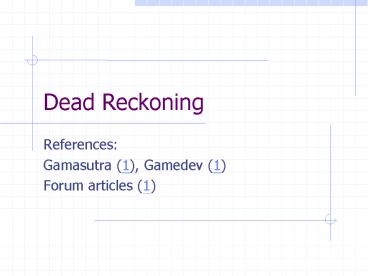Dead Reckoning - PowerPoint PPT Presentation
Title: Dead Reckoning
1
Dead Reckoning
- References
- Gamasutra (1), Gamedev (1)
- Forum articles (1)
2
Introduction
- Fast-paced interaction in twitch games
- Players expect the level of performance of
distributed games to approximate that of single
computer/player game - Solution dedicated network (end-to-end latency
150-200 ms)
3
Dead Reckoning
- From DIS (distributed interactive simulation)
protocol of SIMNET project, DoD, USA - Was for networking tank simulators
- Objectives latency hiding, bandwidth reduction
- Basic Ideas
- Agree in advance on a set of algorithms that can
be used by all players to extrapolate the
behavior of entities - Update threshold how far reality should be
allowed to get from these extrapolations before a
correction is issued
4
Dead Reckoning
If the motion is still within the DR threshold
(on Owner), no updates required.
point-to-point
linear
quadratic
5
DR Algorithm (point-to-point)
- No path
- Noticeably jerky unless one packet is received
per frame
6
DR Algorithm (linear)
moves along this v, until
- Path does not consider change of velocity
7
DR Algorithm (quadratic)
moves along this v and a, until
NewPosition OldPosition Velocitytime
0.5Acceleration(time)2
- Path does not consider change of acceleration
jerk
8
PDU (protocol data unit)
- Data packet representing each entity
- Kinematic state position, velocity,
acceleration, orientation - Other info damage level, turret
- Which dead reckoning algorithm to use
- Threshold jerkiness vs. more PDUs to be sent
9
Smoothing
- Jerkiness due to sudden update of position
- Use smoothing algorithm to lessen the apparent
jerkiness more later
10
Extension
- Predictive Contract
- State-based, rather than kinematic-based
- State drive along road to waypoint
- If the definition of roads, the specific
waypoint, the way of driving (right-side), are
known to all players, the vehicle could be
computed w/o any network traffic - Others turn on/off the sensors, send out
radio report
11
Summary
- Dead reckoning is not free every computer runs
an algorithm to extrapolate each entity - Trade processor cycles to reduced network use and
apparent latency - If all entities behave unpredictably all the
time, DR offers little gain
12
DR Smoothing with Cubic Splines (ref)
- Jerkiness is due to the sudden update of position
- The following method ensures smooth positional
transition while ensuring accuracy by packet
(server) updates - Only cubic (parametric) curve can represent R3
curve quadratic curves are planar - Hermite curves are most common. Two points and
their corresponding tangents need to be specified
(by quadratic kinematics laws)
13
A Draftsmans Spline
14
Math of Hermite Curves
- h1(s) 2s3?3s2 1
- h2(s) ?2s3 3s2
- h3(s) s3 ? 2s2 s
- h4(s) s3 ? s2
- P(s) P1h1(s) P2h2(s) T1h3(s) T2h4(s)
- P(s)P1h1(s) P2h2(s) T1h3(s) T2h4(s)
- h1 6s2 ? 6s h2 ?6s26s h3 3s2 ? 4s1
h4 3s2 2s - Note end tangent vectors are dP/ds
15
Reparameterization
16
Algorithm
- When a packet p,v,a arrives, begin creating a
cubic spline for next position - Approximate (extrapolate) the p,v after time T
- A piece of Hermite curve is defined by two end
points and two end tangents - P1 current position
- T1 (scaled) current velocity
- P2 extrapolated position after T
- T2 (scaled) velocity after T
T estimated interval between packets
17
Details
The position gradually changes from P1 (s0) to
P2 (s1, tT)
Start a new spline by 1. Current p,v 2. New
p,v computed by p,v,a after time T

